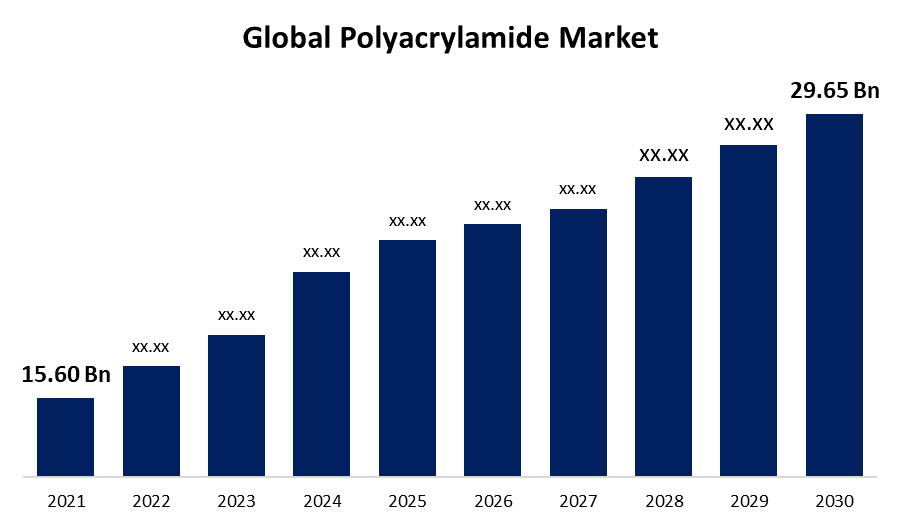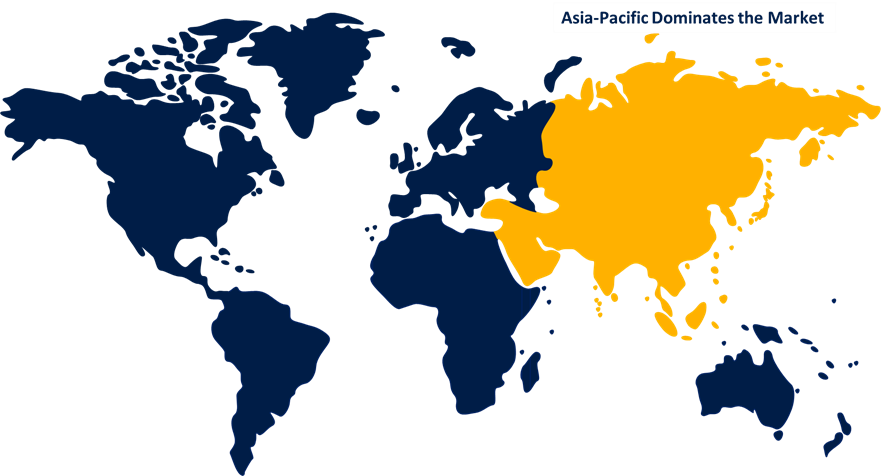Global Polyacrylamide Market Size, Share, and COVID-19 Impact Analysis By Type (Cationic, Anionic, Non-ionic and Others), By Application (Enhanced Oil Recovery, Water Treatment, Mineral processing, Pulp & Paper, and Others) and by Region (North America, Europe, Asia-Pacific, Latin America, Middle East and Africa), Analysis and Forecast 2021 - 2030
Industry: Chemicals & MaterialsGlobal Polyacrylamide Market Insights Forecasts to 2030
- The global Polyacrylamide Market was valued at USD 15.60 Billion in 2021.
- The Market is growing at a CAGR of 7.4% from 2022 to 2030
- The global Polyacrylamide Market is expected to reach USD 29.65 Billion by 2030
- North America is expected to grow the fastest during the forecast period.

Get more details on this report -
The global Polyacrylamide Market is expected to reach USD 29.65 Billion by 2030, at a CAGR of 7.4% during the forecast period 2022 to 2030. The rise of the oil recovery sectors has expanded over time, which has led to an increase in demand for polyacrylamides. Investment in the water treatment industry has increased, which has further driven the global polyacrylamide market.
Market Overview
An organic polymer derived from acrylamide subunits is known as polyacrylamide. N'-methylenebisacrylamide is used to create polyacrylamide, which typically has a straightforward linear-chain structure. However, it may be altered to create branched, highly structured, and cross-linked variations. It is a white, water-soluble solid polymer of acrylamide that is used as a coagulant, flocculant, and filtration aid in various applications. These applications are determined by the polymer's physical form and its ionic type, such as anionic, non-ionic, cationic, and other. It also contains acrylic resin, which has the special ability of polyacrylamides to dissolve in water. Due to its quick disintegration and great efficiency, this has applications in the treatment of industrial and municipal wastewater. Polyacrylamides are being used more and more often in a wide range of applications globally. Enhanced oil recovery demand is driving up demand for polyacrylamide, which is helping the market expand. Additionally, it is anticipated to increase the effectiveness of oil recovery, which is anticipated to increase demand throughout the projection period. The development of wet shale gas and shale gas production in particular are anticipated to positively affect the expansion of the market. Additionally, increased investment in the field of water treatment has increased demand for polyacrylamides. Additionally, polyacrylamide is used in the polyacrylamide market as colour removal agents and additions for cell separation in biotechnological broths, creating market potential. The regulatory agencies' increased focus on water treatment management, such as wastewater treatment facilities and drinking water, particularly in emerging nations, is projected to benefit the expansion of the worldwide polyacrylamide market. Polyacrylamides are also utilised to stabilise soil aggregates and to stop soil erosion. Furrow irrigation and sprinkler irrigation are further uses for this polymer in rain-fed crops. Additionally, polyacrylamide is frequently used as a finishing agent or sizing agent for cloth post-treatment in the textile industry. Due to its anti-wrinkle, softness, and anti-mold protective layer properties as well as its excellent moisture absorption properties, this wide spectrum of textile chemicals is used in the textile sector and aids in lowering the breakage rate of spun yarn. The fabric can acquire great resistance to static electricity and fire thanks to additional polyacrylamide. The product composed of polyacrylamide gives a high level of vividness and excellent adherence. It also serves as a stabiliser for non-silicon polymers. Although the supply and production of polyacrylamide by manufacturing facilities have been negatively impacted by the COVID-19 pandemic due to restrictions placed by various countries, the cost of polyacrylamide transportation has increased as a result, which has caused delays on major carriers around the world. Due to the closing of international borders and the decline in the number of commercial ships, a similar pattern was seen in all major geographic areas. By 2021, though, it's anticipated that the polyacrylamide business will return to normal.
Report Coverage
This research report categorizes the Market for global Polyacrylamide based on various segments and regions, forecasts revenue growth, and analyses trends in each submarket. The report analyses the key growth drivers, opportunities, and challenges influencing the Global Polyacrylamide Market. Recent Market developments and competitive strategies such as expansion, Product launch and development, partnership, merger, and acquisition have been included to draw the competitive landscape in the Market. The report strategically identifies and profiles the key Market players and analyses their core competencies in each global Polyacrylamide Market sub-segments.
Global Polyacrylamide Market Report Coverage
| Report Coverage | Details |
|---|---|
| Base Year: | 2021 |
| Market Size in 2021: | USD 15.60 Billion |
| Forecast Period: | 2021-2030 |
| Forecast Period CAGR 2021-2030 : | 7.4 |
| 2030 Value Projection: | USD 29.65 Billion |
| Historical Data for: | 2017-2020 |
| No. of Pages: | 207 |
| Tables, Charts & Figures: | 110 |
| Segments covered: | By Type, By Application, By Region, COVID-19 Impact Analysis |
| Companies covered:: | SNF FLOERGER, Kemira, BASF, ASHLAND, NALCO, Dia-Nitrix, Mitsui Chemicals, Arakawa Chemical, PetroChina Daqing, Bejing Hengju, Anhui Jucheng Fine Chemicals, Xitao Polymer, Shandong Polymer Biochemicals, Anhui Tianrun Chemicals, Zhengzhou Zhengli Polymer, Xinxiang Boyuan Water-purifying Materials, Zibo Xinye Chemical, Black Rose Industries, and Dongying Kechuang Biochemical. |
| Pitfalls & Challenges: | Due to the increasing number of COVID-19 cases |
Get more details on this report -
Segmentation Analysis
- In 2021, the Anionic segment accounted for the largest share of the Market, with 35.2% and a Market revenue of 5.49 Billion.
Based on the Type, the Polyacrylamide Market is categorized into Cationic, Anionic, Non-ionic and Others. In 2021, the Anionic segment accounted for the largest share of the Market, with 35.2% and a Market revenue of 5.49 Billion. Throughout the forecast period, the Anionic Oil segment is anticipated to maintain its leading position because of its expanding use in wastewater treatment, paper manufacture, and oil recovery operations. The features of anionic, which have a large molecular weight and exhibit significant degrees of polymerization, are the main cause of this increase. Additionally, it demonstrates adaptable qualities including shear, flocculation, dispersibility, thickening, and drag-reduction. Additionally, it is economical, which has increased its widespread use in the industry in particular.
- In 2021, the Oil Recovery segment accounted for the largest share of the Market, with 30.6% and a Market revenue of 4.77 Billion.
Based on the application, the Polyacrylamide Market is categorized Enhanced Oil Recovery, Water Treatment, Mineral processing, Pulp & Paper, and Others. In 2021, the Oil Recovery segment accounted for the largest share of the Market, with 30.6% and a Market revenue of 4.77 Billion. Throughout the forecast period, the Oil Recovery segment is anticipated to maintain its leading position while expanding at the fastest CAGR because of the rising need for better oil recovery, fast urbanisation, and population expansion that is anticipated to have considerable growth throughout the anticipated time. Polyacrylamide is employed in a variety of settings and functions as an agent, including oil drilling additive, drag reduction, and better oil recovery.
Regional Segment Analysis of the Polyacrylamide Market

Get more details on this report -
- North America (U.S., Canada, Mexico)
- Europe (Germany, France, U.K., Italy, Spain, Rest of Europe)
- Asia-Pacific (China, Japan, India, Rest of APAC)
- South America (Brazil and the Rest of South America)
- The Middle East and Africa (UAE, South Africa, Rest of MEA)
Asia Pacific emerged as the largest Market for the global Polyacrylamide Market, with a Market share of around 32.9% and 5.13 Billion of the Market revenue in 2021.
- Asia Pacific emerged as the largest Market for the global Polyacrylamide Market, with a Market share of around 32.9% and 5.13 Billion of the Market revenue in 2021. The demand for Polyacrylamide is being driven by the rising acceptance by the market. The market for Polyacrylamide was dominated by the Asia Pacific region mostly due to the fast expansion of the water treatment sector in China and India is the main driver of the growth. Along with it, nations in the APAC region have made significant contributions to various applications that have shaped the global polyacrylamide market.
- North America Market is expected to grow at the fastest CAGR between 2021 and 2030, Due to the rapid expansion of international trade and industry in the North America region, as well as the growing popularity of seaborne transportation, a significant market opportunity has been created for the Polyacrylamide Market players as a result of increased globalisation, trade operations, and rising imports and exports.
Competitive Landscape
The report offers the appropriate analysis of the key organizations/companies involved within the global Polyacrylamide Market along with a comparative evaluation primarily based on their Product offering, business overviews, geographic presence, enterprise strategies, segment Market share, and SWOT analysis. The report also provides an elaborative analysis focusing on the companies' current news and developments, including Product development, innovations, joint ventures, partnerships, mergers & acquisitions, strategic alliances, and others. This allows for the evaluation of the overall competition within the Market.
List of Key Market Players:
- SNF FLOERGER
- Kemira
- BASF
- ASHLAND
- NALCO
- Dia-Nitrix
- Mitsui Chemicals
- Arakawa Chemical
- PetroChina Daqing
- Bejing Hengju
- Anhui Jucheng Fine Chemicals
- Xitao Polymer
- Shandong Polymer Bio-chemicals
- Anhui Tianrun Chemicals
- Zhengzhou Zhengli Polymer
- Xinxiang Boyuan Water-purifying Materials
- Zibo Xinye Chemical
- Black Rose Industries
- Dongying Kechuang Biochemical
Key Target Audience
- Market Players
- Investors
- Applications
- Government Authorities
- Consulting and Research Firm
- Venture capitalists
- Third-party knowledge providers
- Value-Added Resellers (VARs)
Some of the Key Developments:
- In October 2018, A memorandum of understanding (MOU) was signed by BASF and SINOPEC to deepen their partnership in China to meet rising consumer needs.
- In June 2019, To increase the scope of its product offering, BASF joined with NGK and signed a sales contract.
- In December 2020, Kemira and DuPont Nutrition and Biosciences decided to work together to develop and market ground-breaking biomaterials in order to diversify their product offerings.
- In January 2020, Solvay was acquired by BASF in full, enabling it to increase its offering of technical plastics.
Market Segment
This study forecasts global, regional, and country revenue from 2019 to 2030. Spherical Insights has segmented the global Polyacrylamide Market based on the below-mentioned segments:
Global Polyacrylamide Market, By Type
- Cationic
- Anionic
- Non-ionic
- Others
Global Polyacrylamide Market, By Application
- Enhanced Oil Recovery
- Water Treatment
- Mineral processing
- Pulp & Paper
- Others
Global Polyacrylamide Market, Regional Analysis
North America
- US
- Canada
- Mexico
Europe
- Germany
- Uk
- France
- Italy
- Spain
- Russia
- Rest of Europe
Asia Pacific
- China
- Japan
- India
- South Korea
- Australia
- Rest of Asia Pacific
South America
- Brazil
- Argentina
- Rest of South America
Middle East & Africa
- UAE
- Saudi Arabia
- Qatar
- South Africa
- Rest of Middle East & Africa
Need help to buy this report?